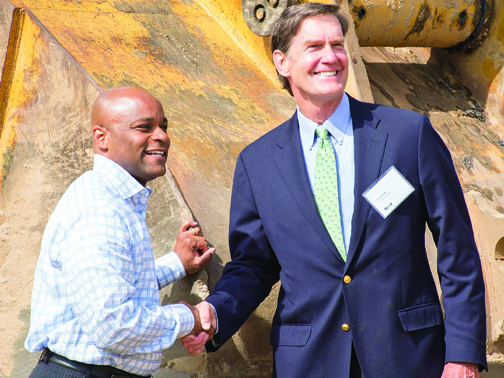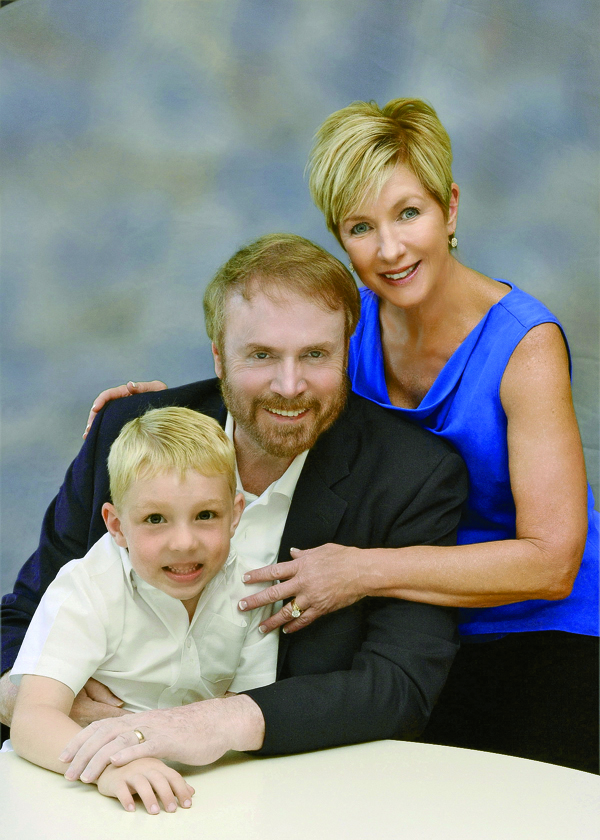
by Mark Smiley | Oct 23, 2017 | Main Articles
Denver City Council Votes 8-5 In Favor
by Lisa Marlin
 On a cool autumn Saturday morning in a northwest Denver neighborhood, children ran through leaves in their front yard, a young man walked a small dog down the sidewalk, and an older woman swept her front porch. If not for the modern clothing they wore and the kinds of cars parked along the curb, an outsider might think they’d stepped back in time because many of the houses here date back to the late 1800s and early 1900s. Most of the homes’ exteriors have changed little over time and now they never will, at least not substantially.
On a cool autumn Saturday morning in a northwest Denver neighborhood, children ran through leaves in their front yard, a young man walked a small dog down the sidewalk, and an older woman swept her front porch. If not for the modern clothing they wore and the kinds of cars parked along the curb, an outsider might think they’d stepped back in time because many of the houses here date back to the late 1800s and early 1900s. Most of the homes’ exteriors have changed little over time and now they never will, at least not substantially.
An 8-5 vote by the Denver City Council in their September 25, 2017, meeting approved the designation of a Landmark Historic District for Preservation of Packard’s Hill, making it the city’s 53rd historic district. Voting in favor of the historic district were councilmembers Brooks, Espinoza, Clark, Kashmann, Kniech, López, New and Ortega. Councilmembers Black, Flynn, Gilmore, Herndon and Susman voted against.
Located near Highland’s Square’s trendy shops and restaurants, the area is approximately within the bounds of Lowell Boulevard and Osceola Street between 32nd and 35th Avenues in West Highland.
The designation ensures the preservation of 173 older homes within the district, known as contributing structures. Demolition of the homes and new builds, while not forbidden, are now strictly limited. A month following the vote, residents on both sides of the issue talked about its impact.
“It means that we can walk up and down our neighborhood and continue to enjoy the fabulous history and character and feel that it is being honored by the city of Denver and the neighbors,” said Marie Benedix who has lived in the neighborhood 10 years. In 2015, Benedix began working with Historic Denver, in partnership with the West Highland Neighborhood Association (WHNA) that received a State Historical Fund grant to research and survey the neighborhood. She would garner 77 signatures of neighbors who supported the designation. She is relieved the ordinance passed.
But not everyone is pleased including Kevin O’Connell who bought a Victorian house here in 1995 with his wife, adding a contemporary home on an adjoining lot in 2003. “All the repairs you do on your house will cost more money,” he said, explaining how the designation adds steps to the city review process for exterior home improvements and additions. Furthermore, he said, “If something happens to our non-contributing structure, we can’t put it back the way it is.”
This is why he organized a group earlier this year called Keep West Highland Free. The group collected 75 signatures to petition against the designation. “We did everything we could in our power as a grass roots organization,” O’Connell said. “Unfortunately, the process is really stacked…”
The public hearing during the council meeting lasted five hours as 80 people representing both sides gave their views.
“With a split constituency, I have to ask my self, what are the consequences of this vote either way?” said Rafael Espinoza who represents Council District 1 where West Highland is located. He expressed surprise at the number of people in opposition, not having been given their petition until that night, but he felt that the criteria for historic designation had been met and it would be better overall for the area. “We’re losing history at an alarming clip. In the other conversations we’ve had about where all the demolitions in Denver are occurring, over 80% of them are in District 1. I believe as the LPC [Land Planning Commission], that it should go through.”
self, what are the consequences of this vote either way?” said Rafael Espinoza who represents Council District 1 where West Highland is located. He expressed surprise at the number of people in opposition, not having been given their petition until that night, but he felt that the criteria for historic designation had been met and it would be better overall for the area. “We’re losing history at an alarming clip. In the other conversations we’ve had about where all the demolitions in Denver are occurring, over 80% of them are in District 1. I believe as the LPC [Land Planning Commission], that it should go through.”
Also in favor was Wayne New of Council District 10. “I have the highest percentage of historic districts in the whole city. I have the high-end Country Club that loves their historic district as much as the moderate priced Alamo Placita. All I get is overwhelming support for their districts because it protects the character of their district. It does deter development that changes character.”
Mary Beth Susman of Council District 5, known for being in favor of high density development in virtually all cases, voted against it citing that the opposition did not have equal access to city resources to prepare their case. “I did speak with Planning last year to ask ‘let’s open this up and take a look because I think both sides should have access to the same city resources.’ I feel very strongly that compromise can be worked out.”
Kevin Flynn of Council District 2 also voted against it. “Because of the deep division in the community, I really believe that this needs more consensus so I believe I have to oppose this.”
A few weeks later, O’Connell said he is still taken back by the vote of the council. He is considering turning one of his homes into rental property, as some of his neighbors have told him they may do as well. “It took a lot of fight out of everyone. It lasted a long time and was a grinding process,” he said. “It has really torn the neighborhood apart.”
On the winning side, Benedix agreed that it was a lot of work, as did Marilyn Quinn from the WHNA design and preservation committee. She lives in the neighboring Ghost Historic District and helped prepare the application. “It has been all-consuming at times and we are very happy that the majority of council agreed with us,” Quinn said. Her committee is planning to offer free design review consultations to help homeowners with the historic guidelines, such as knowing that they can paint their homes any color they choose, but window and door replacements require design review, and contributing structures may only be demolished if economic hardship is established at a public hearing of the Landmark Commission.
Benedix said she’s generating ideas to make the history of Packard’s Hill more available to people who come to visit the area. “It is important to know we have these connections and ties to the people who came before us,” she said.
More information about the Packard’s Hill Historic District and links to the historic guidelines can be found at www.historicdenver.org/packards-hill-proposed-historic-district/.

by Mark Smiley | Sep 25, 2017 | Main Articles
 by Mark Smiley
by Mark Smiley
The unrelenting urbanization of the Cherry Creek and Country Club neighborhoods goes on unabated. The Cherry Creek Shopping Center announced that it had terminated the lease of the Safeway store on the northeast end of the mall where it had been a tenant for over a half century. The Shopping Center is separated from the the gigantic and highly controversial Country Club Tower and Gardens (the “Tower”) by the Denver Country Club green space.
The Tower is, in fact, two 30-story twin skyscrapers that block the view of the mountains for significant Cherry Creek and Country Club areas. The buildings have 533 apartment units, but inadequate parking according to experts which causes the overflow to jam the local streets. The Tower charges premium prices with small studio apartments going for $1,438 and two bedroom two bath units leasing out at $2,151.
With the help of the politically connected real estate lawyer Tom Ragonetti and the highly controversial and widely despised former City Councilman Chris Nevitt, developer Pat Broe received all of the applicable zoning, density and height restrictions waived by the City Council notwithstanding adamant opposition from local neighborhood groups. Critics charged that the parking provided is grossly inadequate and will result in the overflow making on-the-street parking difficult if not impossible on certain days. The Tower looms over the two and three story structures in the West Washington Park area. The massive Towers are slowly being occupied and are anticipated to create traffic nightmares on South Downing Street and Speer Boulevard.
by the City Council notwithstanding adamant opposition from local neighborhood groups. Critics charged that the parking provided is grossly inadequate and will result in the overflow making on-the-street parking difficult if not impossible on certain days. The Tower looms over the two and three story structures in the West Washington Park area. The massive Towers are slowly being occupied and are anticipated to create traffic nightmares on South Downing Street and Speer Boulevard.
One West Washington Park resident Pam Johnson stated, “Our neighborhood’s misery and degradation is Pat Broe’s monetary profit.”
On the other side of the Denver Country Club, Nick LeMasters, the general manager of the Shopping Center, in a press release stated that: “This move underscores the changes happening in the retail sector and the Cherry Creek shopping district as well as our commitment to Cherry Creek Shopping Center’s continued success as the region’s premier shopping destination.”
In a telephone interview with the Chronicle, LeMasters indicated that the Shopping Center had already budgeted a significant investment to redo and update the northeast portion of the Shopping Center where Safeway and Rite Aid wer e once located. He also stated that the Shopping Center had longtime contractual commitments with a new tenant or tenants to take over the space after a complete redo of the area. LeMasters opined that a public announcement on the new tenant or tenants would likely occur late this year or early 2018.
e once located. He also stated that the Shopping Center had longtime contractual commitments with a new tenant or tenants to take over the space after a complete redo of the area. LeMasters opined that a public announcement on the new tenant or tenants would likely occur late this year or early 2018.
The City and County of Denver has significantly reduced the parking requirements for new projects in the Cherry Creek and Country Club/West Washington Park area on the theory that it will cause people to abandon automobiles and take bicycles or public transportation instead, notwithstanding the fact there is no pub lic transportation in this area of the city beyond RTD buses.
lic transportation in this area of the city beyond RTD buses.
The lack of parking in Cherry Creek North due to minimal parking requirements by the City and County of Denver caused the Cherry Creek Shopping Center to install an elaborate paid parking system for anyone visiting the mall with a car for more than one hour. The paid parking resulted in a dramatic public outcry. (See Glendale Cherry Creek Chronicle April 2017 front page story “Denver City Planning Choking Cherry Creek Businesses.”)
While it has been steadily rumored that the Shopping Center intended to construct an apartment house or condominium on a portion of the Shopping Center’s land, General Manger LeMasters reiterated that was simply not true and that the Shopping Center was absolutely committed to being the premier retail shopping center in all of Denver and Colorado.
In fact, Safeway expressed a hope that it may return in some form to the Shopping Center, declaring, “We hope to be given an opportunity to return to the area as the mall considers redevelopment plans over the next several years.” Safeway’s long-term lease had terminated back in December 2015 and the store was apparently on a month to month basis since that time. Back in May 2015 Safeway told the Chronicle that, “We look forward to serving our customers in this neighborhood for years to come.”
The Cherry Creek area was once considered a low density and quaint area, but that is all in the past. It is expected that downtown Denver and the Cherry Creek area will be merged. Already Speer Boulevard from Downing to downtown is becoming canyon-like with increasing high buildings crowding both sides of the road.
It is anticipated that the single-family homes in the Country Club area will disappear similar to what happened to once stately homes along Sherman Street and Colfax Avenue 100 years ago. It is also anticipated that the Denver Country Club which has been at its location since 1905 will move outside the City and County of Denver as it is slowly surrounded by massive apartment buildings.
Denver as it is slowly surrounded by massive apartment buildings.
Critics indicate that Denver under Mayor Hancock has ceased to be a “Cow Town” but what will replace it will be a typical high density and, in many areas, an unpleasant concrete jungle.

by Mark Smiley | Sep 25, 2017 | Main Articles
Some Residents, Users Say The Revamped Loop Road Completed This Summer Is A Travesty
by Glen Richardson

 Denver’s Washington Park was acquired in increments between 1899 and 1904 and designed in stages by Reinhard Schuetz as a green space of lakes, gardens, trees, open area and vistas to be peacefully and quietly enjoyed by the public. “Denver’s Parks & Recreation has un-greened the park by painting red, green and white lines on pavement everywhere and installing controlling signs and stanchions to herd pedestrians, facilitate autos and especially bicycle passage,” declares resident Frank Hegner.
Denver’s Washington Park was acquired in increments between 1899 and 1904 and designed in stages by Reinhard Schuetz as a green space of lakes, gardens, trees, open area and vistas to be peacefully and quietly enjoyed by the public. “Denver’s Parks & Recreation has un-greened the park by painting red, green and white lines on pavement everywhere and installing controlling signs and stanchions to herd pedestrians, facilitate autos and especially bicycle passage,” declares resident Frank Hegner.
Hegner is talking about the 2.2-mile stretch of pavement known as the Loop Road that encircles the park. Changes and a new addition to the route completed this summer threw him and hundreds of other park users for a loop. He tells the Chronicle, “It is only a matter of time before someone is seriously hurt in these merging, confusing lanes of unsightly, costly insanity.”
It is the addition of a third lane not familiar to pedestrians and bicyclists that upset users the most. It’s a “bicycle alley” created by the city as a new fast lane designed especially for them, many tell the Chronicle. “You’d think there was a race track out there,” says David Matthews. He should know, he’s been walking and pedaling the route for 45 years and is a board member of the West Wash Park Neighborhood Assn. In addition to the fast lane the city has painted 150 new stencils on the asphalt path, installed 100 vertical signs explaining the new layout and erected a series of barriers to block cars from turning onto the loop. All at a cost of nearly a quarter of a million dollars.
Political Process
Denver Parks & Recreation’s response is that the changes were made based on comments from residents. “It’s not something we invented,” retorts project supervisor Jason Himick. It is true the parks department listened to residents at three public meetings plus published a 100-page report outlining the plans. In rejoinder, many users tell the Chronicle, “It’s part of the political process whether for a proposed urban development or planned park changes, but the City’s strategy policy always remains unchanged.”
One unidentified speaker at the public meetings even appeared to warn attendees that Parks & Recreation were only practicing a political process: “I’ve had enough experience in the world and as an attorney to know that once consultants are hired, somebody has made up their mind to do something. I would urge that as little as possible be done.” Belinda Bagley who lives on South Franklin says the most accurate statement made by department consultants during those meetings was that the majority of people who use the Park were satisfied with it and did not wish to see it changed. At those meetings she pointed out, “Most of the time the park is not crowded. There are a few peak times when congestion might cause various difficulties, but that is the exception rather than the rule.”
There are, of course, those that are happy with the changes including Tim McHugh, President of FANs (Friends & Neighbors of Wash Park). He says the process included, “a wide variety of park users who consider th e best interests of all who use the Loop Road.” Frank Miltenberger — another park stakeholder — believes the process was fair, though not everyone got everything they wanted.
e best interests of all who use the Loop Road.” Frank Miltenberger — another park stakeholder — believes the process was fair, though not everyone got everything they wanted.
Safety Concerns Overlooked
The single thing residents and users at the public meetings seemed to agree on was that speed is a worry. “Slow is safe,” many suggested. Furthermore, a number of people spoke about concerns, even fear, of bicycles moving at fast speeds. “Anyone moving at speeds that do not allow for quick stops or turns is a concern. The slower the safer,” warned Glen Legowik.
Matthews — the FANs board member who objects to the changes because of bike speed — personally witnessed a serious accident when a bicyclist entering the park from Marion Parkway hit a car coming out. He’s seen less serious altercations among bicyclists and pedestrians when one strays into the other’s lane. “There just need to be a few things that say, ‘slow down, it’s not a race track.’ I’m not at all against people riding their bikes here, but we’ve got to have some way to do it safely.”
As for the signage, Humboldt Street’s Jenna Moore admits the former one-way arrows confused people. But she says all that was needed was to paint an additional arrow pointing the opposite direction where the original pedestrian arrows were painted. Similarly, signage that informed cyclists that they need to stay in their lane would have helped.
Baffling Symbols
For Washington Park Loop Road bikers, walkers, runners, rollerbl ading, and dogs this is what the lanes ahead now look like: The two outer lanes are for one-way wheeled traffic only, each marked by a bicycle and a rollerblade stencil. Unfortunately, however, many are confusing the rollerblade symbol as a footprint-marker indicating use for pedestrian traffic.
ading, and dogs this is what the lanes ahead now look like: The two outer lanes are for one-way wheeled traffic only, each marked by a bicycle and a rollerblade stencil. Unfortunately, however, many are confusing the rollerblade symbol as a footprint-marker indicating use for pedestrian traffic.
The outermost lane is slower; the middle lane is for passing. In at least one stretch the middle lanes open up to car traffic, too. The pedestrian lane, closest to the park interior, has a pedestrian symbol and is reserved for foot traffic and leashed dogs walking in both directions.
Critic Matthews suggests that adding the new lane has squeezed pedestrians to one side. Furthermore, he notes the entire metro area has 10-foot bike paths for two-way traffic but all of a sudden 18-feet is required in Wash Park.
Flawed Process
Ultimately many Washington Park residents feel they were in some sense conned once again by the Hancock Administration generally and the Parks & Recreation Department specifically. Many believe that the administration is attempting to control traffic by making owning an automobile a difficult and expensive proposition.
The transportation alternative preferred by the administration for most people is either bicycles or public transportation. Thus when the Wash Park Loop was being conceptualized the city’s preference for bicycles overrode any input from local residents at the meetings concerning pedestrian travel.
What were all those meetings about?” demanded Matthews of the Deputy Manager of Parks & Recreation Scott Gilmore, who off
ered to “remove some curb” at the narrowest points in the pedestrian lane. (Parks & Recreation later did this.)
But Matthews was angry. “Sc
ott, you took the side of the bikes. They have 18 feet! What about the people?”
Gilmore finally retorted that there were many other paths for people to walk on in Washington Park.
“What I’ve found in this job,” Gilmore said wearily, “is that you can never please everyone. Never. They wanted a safer road. It is so much safer.”
Gilmore did acknowledge he could have “communicated more fully” at various points. “But nobody likes change.”
Back in 2014, the stakeholders asked that the Loop Road’s essential nature not be changed — and that everyone who wanted to use it be accommodated.
It appears Parks & Recreation saw both things weren’t exactly possible. Residents argue that with more honest communication, stakeholders could have been true partners in envisioning the outcome — instead of, as Matthews feared, “being just used to show there was public input.”

by Mark Smiley | Sep 5, 2017 | Main Articles
 Some Exotic Dancers Feel They Are Being Badly Exploited By Class Action Attorneys Here In Colorado And Across The Country
Some Exotic Dancers Feel They Are Being Badly Exploited By Class Action Attorneys Here In Colorado And Across The Country
by Mark Smiley
In a series of class action lawsuits filed in various states, lawyers for exotic dancers claim nightclubs are taking financial advantage of the women regarding employment status. But after recent settlements, some of the putative plaintiff dancers feel that it is the lawyers who are exploiting them, banking millions of dollars while giving the dancers less than what they would make in a single night’s work.
The claims by the dancers are in line with plaintiffs in other class action cases in the United States in which the only substantial beneficiary of the lawsuits are the contingency lawyers themselves. Lawrence Schonbrun in the American Thinker called it “The Class Action Racket.”
He points to the plaintiffs’ lawyers in the Ford Explorer SUV class action cases where the lawyers banked $25 million in attorney fees while the plaintiffs received a $500 coupon toward the purchase of a new Ford vehicle with only 148 plaintiffs bothering to obtain a coupon. Thus all the class plaintiffs combined in that case actually received a total of $74,000 compared to the $25 million bonanza raked in by their attorneys.
In the Bank of Boston class action lawsuit the class members had as a result of the settlement their bank accounts credited with between $2.19 and $8.76 but then had their accounts debited up to $9.00 by the plaintiffs’ lawyers to cover the costs of the litigation. For this dubious benefit for their clients the plaintiffs’ lawyers collected $8.5 million.
Stripper Lawsuits
Plaintiff lawyers in Nevada and Michigan brought lawsuits on behalf of exotic dancers claiming that the strip clubs were violating labor laws regarding classifying the dancers as independent contractors and not employees and not meeting federal minimum wage requirements.
According to the Las Vegas Sun after over a decade of litigation plaintiffs’ lawyers on behalf of a class action of 28,000 dancers and former dancers agreed to a settlement of $6.55 million regarding 64 nightclubs across the country operated by Déjà vu Consulting Inc. The Sun indicated only $935,000 was available to be divided up among dancers who opt for cash payments. Most were to receive only credits against rental and other fees charged by the clubs. The article did not disclose how much in costs of litigation will be taken out and how much the plaintiffs’ attorneys will receive. It is however estimated that the lawyers would take in millions in cash.
Similar class action lawsuits have been filed in Denver by Mari Newman of Killmer, Lane & Newman, LLP. That law firm is best known for losing the lawsuit on behalf of University of Colorado professor Ward Churchill against the University of Colorado for wrongful termination.
Newman has brought separate lawsuits against PT’s Showclub in Denver and Shotgun Willie’s in Glendale (which advertises in the Chronicle). The initial hurdle for any class action appears to be the fact that the exotic dancers agreed to take any controversy, dispute or claim to binding arbitration held pursuant to the Federal Arbitration Act.
Newman takes the position that the exotic dancers are too uneducated and lack the business savvy to understand a provision regarding binding arbitration pursuant to the Federal Arbitration Act.
Extraordinary Contingency Fee
 The Chronicle has obtained a copy of a Retainer Agreement prepared by Killmer, Lane & Newman, LLP signed by an exotic dancer for a case against PT’s Showclub. While plaintiff’s attorneys normally limit themselves to one-third of what is recovered, Newman is apparently demanding 40 percent of the total recovery as well as all costs. Some experts indicate that in their opinion the strippers are the ones being fleeced by their own class action attorneys as has happened in some other class action lawsuits attorneys.
The Chronicle has obtained a copy of a Retainer Agreement prepared by Killmer, Lane & Newman, LLP signed by an exotic dancer for a case against PT’s Showclub. While plaintiff’s attorneys normally limit themselves to one-third of what is recovered, Newman is apparently demanding 40 percent of the total recovery as well as all costs. Some experts indicate that in their opinion the strippers are the ones being fleeced by their own class action attorneys as has happened in some other class action lawsuits attorneys.
In the “Plaintiffs’ Motion to Defer Consideration and Briefing of. Or Deny, Defendants’ Motion to Compel Arbitration” filed in the lawsuit in federal court Mari Newman declared:
“They [strippers] generally lack formal education and are at the bottom of the socio-economic hierarchy. Defendants knew the Plaintiffs lacked the power, resources, and experience to negotiate fair treatment, and used this knowledge to exploit Plaintiffs . . . .”
Experts indicate that if Mari Newman and her firm believe this to be true, how would the dancers have any capacity to enter into a fair and equitable contingency fee agreement with their attorneys? In addition, how would they be able to knowledgably know whether to accept a proposed settlement agreement that doesn’t just enrich the class action plaintiff lawyers? The Motion would appear to be strong evidence against the attorneys should they ever be sued by the dancers for their actions relating to the lawsuit.
As a practical matter, it would appear the vast majority of the dancers at a nightclub like Shotgun Willie’s do have formal education, often into college and beyond and based on what they make at clubs like Shotgun Willie’s, they are far from the “bottom of the socio-economic hierarchy.”
Lawyers Held In Low Regard
 At Shotgun Willie’s the opinion among at least some of the dancers of Ms. Newman and similar class action lawyers was relatively low. One dancer who goes by the stage name “Harper” stated for the record, “Honestly, from my perspective, I actually respect those lawyers a lot less than my fellow dancers, because I think they are making a less honest living than I am.”
At Shotgun Willie’s the opinion among at least some of the dancers of Ms. Newman and similar class action lawyers was relatively low. One dancer who goes by the stage name “Harper” stated for the record, “Honestly, from my perspective, I actually respect those lawyers a lot less than my fellow dancers, because I think they are making a less honest living than I am.”
Harper is a classical syphony harpist and has a master’s degree.
She also indicated that the somewhat paltry settlements for the dancers while vastly enriching the lawyers have become increasingly known. “The lawyers make all the money and those are the only people profiting.”
“Anytime the lawyers walk away with millions and all the entertainers for dozens of clubs split cash of less than a million, yeah, I’d say they [the class action attorneys] are bottom feeders,” said Michele Poague, the Manager of Human Resources at Shotgun Willie’s referring to other lawsuits.
“I think the attorneys are simply money hungry,” said Aumbree Whitmarsh, a former dancer who is now a manager at Shotgun Willie’s.
It appears that in various settlements in other states the dancers at the end do not become employees but retain their independent contractor status notwithstanding the fact that the original claims were that the same was illegal and exploitative.
The lawsuits filed in Colorado by Ms. Newman are expected to last for years if the prior lawsuits across the country are any indication.

by Mark Smiley | Aug 30, 2017 | Main Articles
The Department Directed By Brad Buchanan Is A fiasco And Failure Auditor’s Report States
Hancock Attacks City Auditor Tim O’Brien Claiming He ‘Misrepresented Audit Findings’
by Glen Richardson
 City Auditor Timothy O’Brien hit a massive nerve in the Hancock Administration when he elected to do a routine audit of the Community Planning and Development’s Building Permit process. It was the 17th audit of Denver city operations by the City Auditor this year alone but the backlash from the Mayor’s office was extraordinary.
City Auditor Timothy O’Brien hit a massive nerve in the Hancock Administration when he elected to do a routine audit of the Community Planning and Development’s Building Permit process. It was the 17th audit of Denver city operations by the City Auditor this year alone but the backlash from the Mayor’s office was extraordinary.
In his press release the City Auditor stated, “Long wait times and disorganized filing systems are delaying the issuance of building permits as intensive development continues in Denver.”
The Mayor’s office then sent a scathing letter attacking O’Brien declaring “your office issued a press release that politicized, dramatized and in some cases misrepresented the audit findings.”
The Mayor then declared, “The result of pushing out this promotion with no recognition of the improvements and innovations implemented and underway is that the employees are needlessly undermined.”
Reason For Mayor’s Reaction
The extreme reaction of a usually somnolent Denver Mayor Michael Hancock can only be understood say insiders by understanding that the Planning Department is run by the highly controversial Executive Director Brad Buchanan. He is accused by neighborhood leaders of selling out the citizens  and neighborhoods of Denver in favor of high density developers and having a history of alleged ethical improprieties.
and neighborhoods of Denver in favor of high density developers and having a history of alleged ethical improprieties.
They cite the deliberate refusal to consider the impact of parking and
traffic concerns in the approval process in order to create greater profitability for developers. Buchanan’s quixotic interpretation of a minor change in the City’s planning code regarding small lots set off a micro unit development explosion. In a highly unusual slap at Buchanan, the City Council earlier this year rejected his proposed pro developer compromise and adopted one proposed by community groups.
Buchanan’s Incompetence
The City Auditor’s claim that Buchanan is simply incompetent in undertaking the mundane tasks of his Planning Department set Buchanan “off the deep end” according to sources within the Planning Department. Tensions are rising with the scale of new developments as cranky contractors and irritated do-it-yourselfers wait in line for hours to get permit approval to hammer, hang drywall, do masonry, carpentry and installation.
Brad Buchanan lives on a 1,500 acre ranch on Kiowa Creek an hour fro
m Denver and his purported lack of a strong work ethic and long commu tes are said to hinder the Planning Department’s ability to keep pace with needed improvements.
tes are said to hinder the Planning Department’s ability to keep pace with needed improvements.
The audit found lines to file construction permits with the department began hours before the office opens, and people have had to spend hours waiting to get help. Long wait times and disorganized filing systems are delaying the issuance of building permits as intensive development continues throughout the city. “A booming population means booming construction, and with that, a high demand for construction permits,” CPA O’Brien concludes.
Six-Month Backlog
Auditors found no defined organizational system and increased time wasted by staff searching for needed documents. Approved plans for archiving are backlogged by at least six months. Moreover, they found that although customer feedbac

k is provided and tracked, there is little or no management process for addressing the issues from customers. Furthermore, “Best practices, standardized by federal executive orders, have not been implemented.”
An audit of Planning’s Development Services division revealed inefficiencies in the permit intake process resulted in an average wait time of more than 1.5 hours for submission of a commercial or residential building permit. When compared to reported wait times in Aurora, Colorado Springs and San Diego, the division exceeds the average of 30 to 45 minutes.
The development services division also lacks a defined periodic review process of building permit fees, which are intended to partially or fully cover operational costs. Additionally, the division staff reported the City typically charges less for permits than surrounding municipalities. “This may shift some cost to the taxpayers,” the audit warns.
Rejects Technical Help
How has the City Planning Department staff responded so f ar to the issues identified by the City Auditor’s Office to resolve key issues?
ar to the issues identified by the City Auditor’s Office to resolve key issues?
The Department responsible for implementing visionary city planning and ensuring safe, responsible and sustainable building throughout Denver has gone into its customary slowdown syndrome. It has agreed to address the long lines by training staff, but not until the end of next year (2018).
The department also says it will begin putting together a system to update its paper filing system through organization and the use of digital storage. The department also says it will try to develop a management process to act in response to the issues being reported from customer feedback. Officials also suggest they will review the fee process the audit indicates is possibly shifting department expenditures to Denver taxpayers.
Ironically Buchanan and the Planning Department refused to work collaboratively with Technology Services, the central information technology department for the City and County of Denver. That was the final recommendation made by the City Auditor. The recommendation would have ensured that former division employee access to the internal system Accela had been revoked. Although there apparently is a secondary internal failsafe to prevent former employees from logging into the system, it is still the agency’s responsibility to notify TS of terminated employees to revoke permissions.
Mayor’s Quandary
Critics indicate that Mayor Hancock has little understanding of how Denver’s various departments actually function. The normal reaction of a Mayor in Denver to an adverse audit report from the City Auditor would be to sit down with the head of a particular department and see how improvements could be made to address the concerns raised in the audit.
But Michael Hancock is not an ordinary Mayor. He was elected primarily due to the support of Pat Hamill and other developers who have funded and run his campaigns. They put Brad Buchanan into his position of Executive Director and depend upon him and his Planning Department for most, if not all, of the real estate schemes that they want implemented.
Thus any criticism of Buchanan and his Department, no matter how mundane, from a trusted source such as the City Auditor’s office must be meet with fierce and absolute resistance. Mayor Hancock certainly signed the letter to O’Brien but few in the city government believe he wrote it or even understood much of its content. According to some the Mayor’s letter has been a public relations disaster as it has brought unwanted attention to Buchanan and his Planning Department at a time when they want to avoid public scrutiny to the greatest extent possible.

by Mark Smiley | Jul 24, 2017 | Main Articles
by Mark Smiley
 Chuck Bonniwell, the Publisher of the Glendale Cherry Creek Chronicle, and his wife Julie Hayden, an Emmy award-winning investigative reporter formerly with Channel 7 and Fox 31 News, have taken over the critical afternoon drive time slot (4 p.m. to 7 p.m.) for 710 KNUS radio. They have replaced longtime radio icon Steve Kelly and Krista Kafer, a semi-regular columnist for The Denver Post.
Chuck Bonniwell, the Publisher of the Glendale Cherry Creek Chronicle, and his wife Julie Hayden, an Emmy award-winning investigative reporter formerly with Channel 7 and Fox 31 News, have taken over the critical afternoon drive time slot (4 p.m. to 7 p.m.) for 710 KNUS radio. They have replaced longtime radio icon Steve Kelly and Krista Kafer, a semi-regular columnist for The Denver Post.
Kelly is retiring from radio work and reportedly has acquired a home in Florida. Kafer has indicated that she is looking into other openings both in and outside of radio.
Bonniwell and Hayden already do a top-rated Saturday morning show for KNUS, Weekend Wake Up with Chuck and Julie, which will continue. Thus Bonniwell and Hayden will be doing three hours of live radio on 710 KNUS six days a week.
The timing of the show is fortuitous as Hayden just won the third Emmy award of her television career on Saturday, July 15, 2017, for a story she did for KDVR television last year about the death of a baby due to neglect at a child care center. Hayden announced several month s ago she was leaving KDVR television after 30 years in the business in order to help with her daughter’s cable television programs as well as take on independent programs.
s ago she was leaving KDVR television after 30 years in the business in order to help with her daughter’s cable television programs as well as take on independent programs.
“Everything has come together perfectly for me,” stated Hayden. “You really don’t want to be an on-air television reporter forever. No matter how well you take care of yourself at some point it becomes clear you are working with people less than half your age. I was able get out winning another Emmy, while at the same time having great opportunities in independent television, radio and the Chronicle.”
For his part Bonniwell views the drive time slot at 710 KNUS as an extraordinary adventure which may have a limited shelf life. “I have a full-time job running the Glendale Cherry Creek Chronicle and I have a separate law practice,” said Bonniwell. “Also, Julie and I didn’t have Rev [their 6-year-old son] so he could be a latchkey child. Having a hit radio show on Saturday morning is just fine. Doing radio full-time is not what I had contemplated, but the opportunity was presented to us and so we agreed to ride the wave for a little while anyway.”
710 KNUS came to dominate the talk radio world in Denver, after longtime radio legend Peter Boyles came to the station four years ago, after being fired by 630 KHOW as a result of a minor altercation with his longtime producer Greg Hollenback. KNUS has a smaller radio signal than its major competitors 850 KOA, 630 KHOW and 560 KLZ.
But the star power that Boyles brought over to the station has totally altered the talk radio landscape, in part because more and more listeners utilize their computer or mobile device to pick up shows. Boyles was recently the subject of a highly positive piece on his career by Mike Roberts in Westword.
Bonniwell and Hayden had a popular Saturday morning show on 850 KOA for several years until they were let go as part of a massive nationwide cost-cutting plan to save Clear Channel Radio (now iHeartRadio) from having to go into bankruptcy. The national radio giant which owns hundreds of stations had crippling indebtedness imposed on it as part of the acquisition of it by Bain Capital Partners (Mitt Romney’s old firm) and Thomas H. Lee Partners for $26.7 billion in November of 2006. iHeartRadio lost $300 million last year.
Salem Corporation which owns 710 KNUS also owns stations across the country but is a much smaller enterprise and is, according to SEC filings, profitable.
What is it like for a married couple to do a radio program together six days a week? “Luckily we have a great time together on and off air,” noted Hayden.
Bonniwell weighed in, “We have an enormous amount of fun and I think it comes across on air. We are there to entertain our listeners. I have my opinions, Julie has hers, our guests have theirs and the listeners and callers have theirs. We don’t pretend to have any corner on truth and any and all opinions are welcome. If Julie and I took ourselves and our opinions too seriously it could be contentious, but luckily we don’t … at least most of the time.”

 On a cool autumn Saturday morning in a northwest Denver neighborhood, children ran through leaves in their front yard, a young man walked a small dog down the sidewalk, and an older woman swept her front porch. If not for the modern clothing they wore and the kinds of cars parked along the curb, an outsider might think they’d stepped back in time because many of the houses here date back to the late 1800s and early 1900s. Most of the homes’ exteriors have changed little over time and now they never will, at least not substantially.
On a cool autumn Saturday morning in a northwest Denver neighborhood, children ran through leaves in their front yard, a young man walked a small dog down the sidewalk, and an older woman swept her front porch. If not for the modern clothing they wore and the kinds of cars parked along the curb, an outsider might think they’d stepped back in time because many of the houses here date back to the late 1800s and early 1900s. Most of the homes’ exteriors have changed little over time and now they never will, at least not substantially.
 self, what are the consequences of this vote either way?” said Rafael Espinoza who represents Council District 1 where West Highland is located. He expressed surprise at the number of people in opposition, not having been given their petition until that night, but he felt that the criteria for historic designation had been met and it would be better overall for the area. “We’re losing history at an alarming clip. In the other conversations we’ve had about where all the demolitions in Denver are occurring, over 80% of them are in District 1. I believe as the LPC [Land Planning Commission], that it should go through.”
self, what are the consequences of this vote either way?” said Rafael Espinoza who represents Council District 1 where West Highland is located. He expressed surprise at the number of people in opposition, not having been given their petition until that night, but he felt that the criteria for historic designation had been met and it would be better overall for the area. “We’re losing history at an alarming clip. In the other conversations we’ve had about where all the demolitions in Denver are occurring, over 80% of them are in District 1. I believe as the LPC [Land Planning Commission], that it should go through.”






















